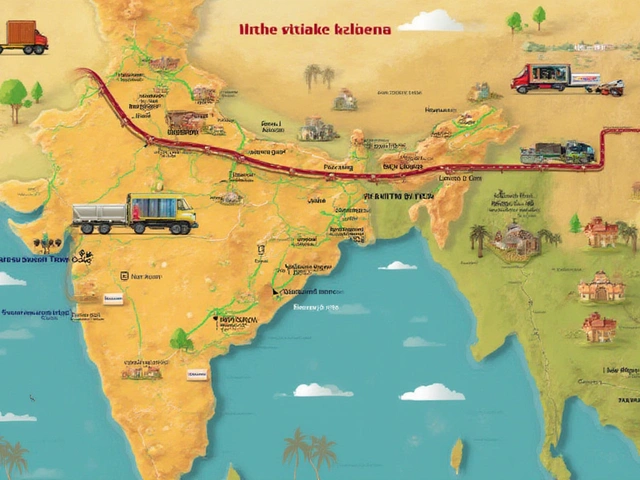Economic Order Quantity (EOQ) Calculator
This tool calculates the optimal order quantity that minimizes total inventory costs, including ordering and holding costs.
Quick Take
- Logistics relies on math for routing, scheduling, and cost reduction.
- Core techniques include linear programming, statistics, and simulation.
- Even basic inventory formulas are pure math.
- Software automates the heavy calculations, but the concepts stay the same.
- Understanding the math helps you make better operational decisions.
Ever wondered if the people moving pallets and trucks are secretly mathematicians? The short answer: yes, a lot of math hides behind every shipping label, route plan, and stock‑room shelf. This article peels back the layers, showing you exactly which equations and algorithms power modern logistics and why they matter to anyone who ships, stores, or delivers goods.
What Is Logistics?
Logistics is the planning, execution, and control of the movement and storage of goods, services, and related information from point of origin to point of consumption. In everyday language it’s the glue that connects factories, warehouses, and customers. While the term sounds like a simple coordination problem, the reality is a complex web of constraints that only math can untangle.
Core Math Areas in Logistics
Transportation Planning & Routing
Routing optimization is the process of determining the most efficient paths for vehicles to travel while satisfying delivery windows, capacity limits, and other constraints. The classic "Traveling Salesman Problem" (TSP) illustrates the challenge: find the shortest possible route that visits each city once and returns to the start. Solving TSP exactly is computationally hard, so logisticians use heuristics like the Nearest Neighbor or more advanced meta‑heuristics such as Genetic Algorithms.
Inventory Management & Economic Order Quantity
Inventory optimization is the practice of balancing stock levels to minimize holding costs while avoiding stock‑outs. The cornerstone formula is the Economic Order Quantity (EOQ):
EOQ = \sqrt{\frac{2DS}{H}}
where D = annual demand, S = ordering cost per order, and H = holding cost per unit per year. Even this simple square‑root equation is pure math, yet it drives millions of dollars in savings.
Demand Forecasting
Demand forecasting is the statistical prediction of future product requirements based on historical sales, seasonality, and market trends. Techniques range from simple moving averages to sophisticated ARIMA models and machine‑learning regressors. Accurate forecasts reduce excess inventory and improve service levels, turning raw numbers into actionable plans.
Warehouse Layout & Space Utilization
Warehouse layout design is the geometric arrangement of storage locations, aisles, and equipment to maximize picking efficiency. Mathematicians apply concepts from operations research, such as the assignment problem, to match high‑velocity items to the closest picking zones. The resulting reduction in travel distance can be expressed as a percentage improvement over a baseline.
Cost Modeling & Linear Programming
Linear programming is a method for optimizing a linear objective function subject to linear equality and inequality constraints. In logistics, LP models decide how many trucks to dispatch, which warehouses to use, and how much inventory to hold, all while minimizing total cost. The classic "Diet Problem" is a relatable example that shows how variables, constraints, and an objective interact.
Real‑World Example: A Regional Distributor
Imagine a mid‑size distributor serving 120 retail stores across Ontario. Before applying math, the team used intuition to assign drivers, ending up with an average route length of 250 km per day and frequent missed delivery windows.
After implementing a routing‑optimization algorithm, average route length dropped to 190 km-a 24% reduction in fuel costs. Simultaneously, applying EOQ to the top‑selling SKU cut annual holding costs by $45,000. Finally, a seasonal ARIMA forecast trimmed safety stock by 15%, freeing up warehouse space for new product lines. All three gains stem from the same underlying mathematics.

Choosing the Right Mathematical Tool
| Technique | Best For | Complexity | Typical Software Support |
|---|---|---|---|
| Linear Programming | Cost minimization, resource allocation | Medium - requires formulation of constraints | Solver engines in Excel, Gurobi, CPLEX |
| Heuristics (e.g., Savings, Sweep) | Vehicle routing where speed outweighs optimality | Low - easy to implement | Route4Me, OptimoRoute |
| Simulation (Monte‑Carlo) | Risk assessment, demand variability | High - many runs needed | AnyLogic, Simio |
| Statistical Forecasting (ARIMA, Exponential Smoothing) | Predicting demand trends | Medium - requires historical data | R, Python (statsmodels), SAP IBP |
Common Pitfalls and How to Dodge Them
- Ignoring data quality. Garbage‑in, garbage‑out applies to every model. Clean, timely data is the foundation.
- Over‑optimizing for a single metric. Focusing only on distance can increase labor hours or breach delivery windows.
- Relying on static parameters. Costs, fuel prices, and demand patterns change; keep your models refreshed.
- Skipping sensitivity analysis. Test how solutions react to changes in key inputs-this reveals hidden risks.
Tools That Turn Math Into Action
Modern logistics platforms embed the math we just covered. Transportation Management Systems (TMS) is software that automates carrier selection, route planning, and freight audit using optimization algorithms. Warehouse Management Systems (WMS) use slotting algorithms to arrange inventory based on pick frequency. Cloud‑based analytics suites, like Power BI or Tableau, let you visualise forecast errors and cost impacts in real time.
Bottom Line
If you ever thought logistics was just about trucks and pallets, think again. Behind every on‑time delivery lies a lattice of equations, statistical models, and optimization routines. Mastering the logistics math basics-routing, inventory, forecasting, and linear programming-gives you the power to cut costs, improve service, and make data‑driven decisions that scale.
Frequently Asked Questions
Do I need a math degree to work in logistics?
Not necessarily. While a solid grasp of algebra, statistics, and basic optimization helps, most day‑to‑day tasks are supported by software that hides the heavy calculations. Understanding the concepts, however, makes you a better decision‑maker.
What’s the simplest math you can apply right now?
Start with the EOQ formula for your top‑selling items. Plug in your annual demand, ordering cost, and holding cost to see immediate inventory savings.
How accurate do demand forecasts need to be?
Accuracy depends on your service level goals. A mean absolute percentage error (MAPE) under 10% is generally good for stable SKUs, while newer or seasonal items may tolerate higher error if you keep safety stock flexible.
Can I use free tools for routing optimization?
Yes. Open‑source libraries like OR‑Tools (Google) and pgRouting (PostgreSQL) let you build custom route planners without licensing fees.
What’s the biggest mistake when applying math to logistics?
Treating a model as a silver bullet without validating it against real‑world constraints. Always pilot, compare outcomes, and adjust parameters as conditions evolve.





